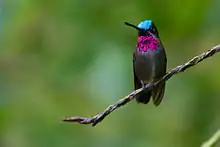Long-billed starthroat
The long-billed starthroat (Heliomaster longirostris) is a hummingbird that breeds from southern Mexico to Panama, from Colombia south and east to Bolivia and Brazil, and on Trinidad. It is present throughout South and Central America and is an uncommon but widespread species, which appears to be a local or seasonal migrant, although its movements are not well understood.
| Long-billed starthroat | |
|---|---|
 | |
| Scientific classification | |
| Kingdom: | Animalia |
| Phylum: | Chordata |
| Class: | Aves |
| Order: | Apodiformes |
| Family: | Trochilidae |
| Genus: | Heliomaster |
| Species: | H. longirostris |
| Binomial name | |
| Heliomaster longirostris | |
 | |
| Distribution | |
Habitat
This hummingbird inhabits forest, and is usually seen in woodland clearings, but will sometimes visit gardens. The female long-billed starthroat lays two eggs in a small cup nest in a tree.
Description
The long-billed starthroat is 10.2 cm long and weighs 6.8 g. The black bill is straight and very long, at about 3.5 cm. The male has bronze-green upperparts, a blue crown, white moustachial stripe and reddish throat. The underparts are grey shading to white on the flanks and mid-belly, and the tail is mainly black. The female is similar, but has a green crown and a purple-edged black throat.
Long-billed starthroats feed on nectar, taken from a variety of flowers, and some insects. The song of this species while feeding is a light weet.
.jpg.webp) Male, Panama
Male, Panama Female - Morti, Panama
Female - Morti, Panama_(15617223925).jpg.webp) Male
Male
References
- BirdLife International (2012). "Heliomaster longirostris". IUCN Red List of Threatened Species. 2012. Retrieved 26 November 2013.CS1 maint: ref=harv (link)
External links
- Long-billed starthroat videos on the Internet Bird Collection
- Stamps for Guyana, (with RangeMap)
- Photo-High Res VIREO photo, from www.natureserve.org
- Long-billed starthroat photo gallery VIREO
